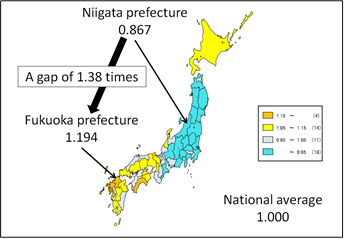Column Finance and the Social Security System 2018.01.22
【Aging, safety net and fiscal crisis in Japan】No.10: Regional Differences in Medical Expenses
In Japan, medical treatment fees for healthcare institutions are uniformly applied nationally as determined by the government. However, medical expenses per capita have wide regional differences. The Ministry of Health, Labor, and Welfare prepares an index by prefecture (47 in Japan) to measure regional differences in medical expenses. The index is calculated excluding the age factor, which greatly affects medical expenses per capita.
As shown in Figure 1, in Fukuoka prefecture, which has the largest index, the medical expenses per capita are 38% higher than that of Niigata prefecture. Moreover, as shown in Table 1, Fukuoka prefecture is inferior to Niigata prefecture in both average life expectancy and healthy life expectancy (the average age reached before daily life activities become limited).
It can not necessarily be said that high medical expenses are correlated with health improvement. As such, the government has already amended the law to introduce a medical treatment fee system for each prefecture. Therefore, even if there is resistance from medical institutions, it is expected that the medical treatment fee systems will be implemented in the near future.


Source: Data released by Ministry of Health, Labor, and Welfare
